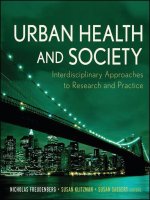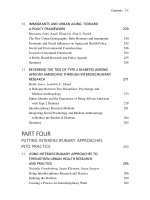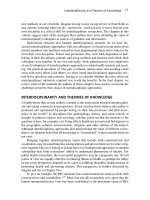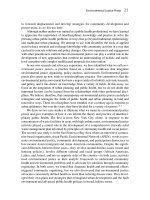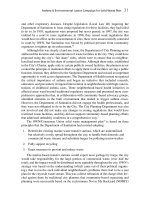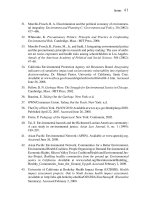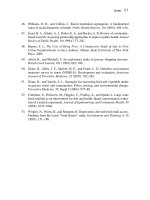Urban Health and Society: Interdisciplinary Approaches to Research and Practice - Part 21 pps
Bạn đang xem bản rút gọn của tài liệu. Xem và tải ngay bản đầy đủ của tài liệu tại đây (106.49 KB, 10 trang )
Notes 181
20. Ford, J., Burrows, R., and Nettleton, S. Home Ownership in a Risk Society:
A Social Analysis of Mortgage Arrears and Possessions. Bristol, UK: Polity
Press, 2001.
21. Nettleton, S., and Burrows, R. Families coping with the experience of mortgage
repossession in the “ new landscape of precariousness. ” Community, Work &
Family, 4, no. 3 (2001): 253 – 272.
22. Nettleton, S., and Burrows, R. Mortgage debt, insecure home ownership and
health: An exploratory analysis. Sociology of Health & Illness, 20, no. 5 (1998):
731 – 753.
23. Coburn, D. Beyond the income inequality hypothesis: Class, neo - liberalism, and
health inequalities. Social Science & Medicine, 58, no. 1 (2004): 41 – 56.
24. Schoen, C., Osborn, R., Bishop, M., and How, S. The Commonwealth Fund 2007
International Health Policy Survey in Seven Countries. New York: The
Commonwealth Fund, 2007.
25. Coburn, D. Income inequality, social cohesion and the health status of popula-
tions: The role of neo - liberalism. Social Science & Medicine, 51, no. 1 (2000):
135 – 146.
26. Harvey, D. A Brief History of Neoliberalism. Oxford, UK: Oxford University
Press, 2005.
27. Marmot, M., and Wilkinson, R., eds. Social Determinants of Health. Oxford,
UK: Oxford University Press, 1999.
28. Wilkinson, R. Unhealthy Societies: The Affl ictions of Inequality. New York:
Routledge, 1996.
29. Brenner, N., and Theodore, N. Cities and the geographies of actually existing
neoliberalism. Antipode, 34, no. 3 (2002): 349 – 378.
30. Peck, J., and Tickell, A. Neoliberalizing space. Antipode, 34, no. 3 (2002):
380 – 440.
31. Saegert, S., Fields, D., and Libman, K. Defl ating the dream: Radical risk and the
neoliberalization of homeownership. Journal of Urban Affairs, in press.
32. Acevedo - Garcia, D. A conceptual framework of the role of residential segrega-
tion in the epidemiology of infectious diseases. Social Science & Medicine, 51,
no. 8 (2000): 1143 – 1161.
33. Apgar, W., and Calder, A. The dual mortgage market: The persistence of discrim-
ination in mortgage lending. In X. S., Briggs ed., The Geography of Opportunity:
Race and Housing Choice in Metropolitan America, pp. 101 – 126. Washington
D.C.: Brookings Institution Press, 2005.
c07.indd 181c07.indd 181 6/3/09 12:02:53 PM6/3/09 12:02:53 PM
182 The U.S. Foreclosure Crisis as It Relates to Health
34. Howell, B. Exploiting race and space: Concentrated subprime lending as housing
discrimination. California Law Review, 94, no. 10 (2006): 101 – 147.
35. Williams, R., Nesiba, R., and McConnell, E. D. The changing face of inequality
in home mortgage lending. Social Problems, 52, no. 2 (2005): 181 – 208.
36. Wyly, E. K., Atia, M., Foxcroft, H., Hammel, D. J., and Phillips - Watts, K.
American home: Predatory mortgage capital and neighborhood spaces of race
and class exploitation in the United States. Geografi ska Annaler, 88B, no. 1
(2006): 105 – 132.
37. Glied, S., and Mahato, B. The widening health care gap between high - and low -
wage workers. New York: The Commonwealth Fund, 2008.
38. Daly, H., Oblak, L., Seifert, R., and Shellenberger, K. Into the red to stay in the
pink: The hidden cost of being uninsured. Health Matrix, 12 (2002): 39 – 61.
39. Schoen, C., Collins, S., Kriss, J., and Doty, M. How many are underinsured? Trends
among U.S. adults, 2003 and 2007. Health Affairs, 27, no. 4 (2008): w298 – w309
(published online).
40. Schoen, C., Osborn, R., Bishop, M., Peugh, J., and Murukutla, N. Toward Higher
Performance Health Systems: Adults ’ Health Care Experiences in Seven
Countries. New York: The Commonwealth Fund, 2008.
41. Davis, K., and Schoen, C. Mirror, Mirror on the Wall: An International Update
on the Comparative Performance of American Health Care. New York: The
Commonwealth Fund, 2007.
42. Cylus, J., and Anderson, G. F. Multinational Comparisons of Health Systems.
New York: The Commonwealth Fund, 2007.
43. Coburn, J. Confronting the challenges of reconnecting urban planning and public
health. American Journal of Public Health, 94, no. 4 (2004): 541 – 549.
44. Immergluck, D. From the subprime to the exotic: Excessive mortgage market
risk and foreclosures. Journal of the American Planning Association, 74, no. 1
(2008): 59 – 76.
c07.indd 182c07.indd 182 6/3/09 12:02:53 PM6/3/09 12:02:53 PM
PART
3
INTERDISCIPLINARY
APPROACHES TO
INTERVENTIONS
TO PROMOTE
URBAN HEALTH
c08.indd 183c08.indd 183 6/3/09 12:03:54 PM6/3/09 12:03:54 PM
c08.indd 184c08.indd 184 6/3/09 12:03:54 PM6/3/09 12:03:54 PM
CHAPTER
8
TRANSDISCIPLINARY
ACTION RESEARCH
ON TEEN SMOKING
PREVENTION
JULIANA FUQUA, DANIEL STOKOLS, RICHARD HARVEY,
ATUSA BAGHERY, LARRY JAMNER
LEARNING OBJECTIVES
■ Describe and compare the three types of interdisciplinary collaboration within
action research teams: (a) scientifi c collaborations among research investigators,
(b) community problem - solving coalitions in which researchers work with
community members to translate scientifi c knowledge into community
problem - solving strategies, and (c) intersectoral partnerships involving
representatives of organizations who work together to reduce health
problems.
■ Identify organizational and individual factors that facilitate or impede
interdisciplinary collaboration among different constituencies.
c08.indd 185c08.indd 185 6/3/09 12:03:54 PM6/3/09 12:03:54 PM
186 Transdisciplinary Action Research on Teen Smoking Prevention
■ Describe the value of interdisciplinary action research to reduce the health
problems associated with tobacco use.
■ Discuss the strategies the Tobacco Policy Consortium used to overcome the
organizational problems it encountered.
INTRODUCTION
This chapter presents a case study of transdisciplinary (TD) action research involving
a consortium of tobacco scientists at the University of California, Irvine, and commu-
nity decision makers based in Orange County, California. The participants in this
university - community partnership focused their efforts on the growing problem of
adolescent tobacco use in urban and suburban settings. The members of this Tobacco
Policy Consortium (TPC) collaborated closely over a two - year period to produce and
disseminate an evidence - based Research and Policy Brief on Preventing Youth
Smoking.
1
In the ensuing sections of the chapter, we (a) discuss key principles of TD
action research and present a selective review of recent literature on TD collaboration
in scientifi c and community settings; (b) describe the goals, organization, and collab-
orative activities of the TPC; (c) summarize the observational, interview, and survey
research methods that were used to study processes of TD action research over the
course of the TPC project; (d) present empirical fi ndings concerning important factors
that either facilitated or constrained effective collaboration among TPC members; (e)
summarize “ lessons learned ” from the TPC study; and (f) suggest potentially useful
research directions that could serve to strengthen the science and practice of transdis-
ciplinary action research in future years.
REVIEW OF TRANSDISCIPLINARY ACTION RESEARCH
Transdisciplinary (TD) action research comprises at least three kinds or phases of col-
laboration: (a) scientifi c collaborations among research investigators, (b) community
problem - solving coalitions in which researchers work with community members to
translate scientifi c knowledge into community problem - solving strategies, and (c)
inter sectoral partnerships involving representatives of organizations situated at local,
state, national, and international levels, who work together to improve environmental,
social, and health problems.
2
The two - year TPC offered participant observers a unique
vantage point from which to investigate and evaluate the processes and outcomes of
TD action research.
In the 1940s, Lewin
3
called upon fellow psychologists to engage in “ action
research, ” or efforts to apply scientifi c research and knowledge to the resolution of soci-
etal problems. As Stokols
2
noted, Lewin believed that psychologists should apply their
scientifi c expertise to the analysis and amelioration of community problems such as
racial prejudice and public health problems. Lewin inspired many psychologists to
embrace the tenets of action research in their own work, although the vast majority of
c08.indd 186c08.indd 186 6/3/09 12:03:54 PM6/3/09 12:03:54 PM
Transdisciplinary Action Research Cycle 187
behavioral scientists continued to pursue more experimental, laboratory - based studies
rather than undertake research for purposes of resolving social problems.
During the 1960s and 1970s, psychologists were confronted by growing socie-
tal concerns about overcrowding, the depletion of natural resources, environmental
degradation, and racial violence in cities like Detroit, Newark, and Los Angeles. Problem -
focused research in fi elds such as environmental, ecological, and community psychol-
ogy expanded rapidly, and collaborations among behavioral scientists and community
members ensued in an effort to ameliorate social and environmental problems.
4
–
6
Ye t ,
participants in these university - community coalitions found the collaborative process to
be quite daunting.
7
–
8
Among the challenges they faced were team members ’ divergent
and confl icting expectations and goals. Psychologists seemed to be prepared only to edu-
cate community members about their fi ndings in short - term collaborations, character-
ized by Sommer
9
as the “ hit and run ” model of community partnering. Researchers
participating in these coalitions seemed to rely heavily on a model commonly used in
science and engineering — that is, take scientifi c fi ndings and then unidirectionally apply
them to solve a problem (without much input from the community partners). This model
is contrary to the ideals of community - based participatory research in which university -
based scientists work closely and reciprocally with community members (with ongoing
discussion between researchers and community partners) to understand and discover the
best methods for solving a social problem.
10
Scholars soon realized that more effective strategies for facilitating action research
needed to be developed, especially those that promote nonhierarchical and equitable
working relationships among community members and university - based scholars.
11
–
14
Stokols
2
built upon Lewin ’ s original conceptualization of action research, which focused
primarily on psychological science and did not give explicit attention to the logistical
and organizational challenges associated with interdisciplinary and/or interprofessional
collaboration. Stokols ’ conceptualization of the science of TD action research has two
major themes. It encompasses scientists who are trained in and working in different
fi elds, community decision makers and practitioners, and representatives from multiple
sectors of society (e.g., education, public health, academia, local and state government).
It also gives explicit attention to the empirical study of factors that facilitate or impede
TD collaboration toward the goal of enhancing the effectiveness of ongoing and future
collaboration among scientists and nonacademicians.
15
TRANSDISCIPLINARY ACTION RESEARCH CYCLE
As noted earlier, transdisciplinary action research incorporates at least three kinds of
collaboration that occur sequentially over different phases — namely, those involving
purely scientifi c collaborations aimed at creating new intellectual products such as
novel conceptual frameworks and empirical knowledge; community problem - solving
coalitions in which researchers from different fi elds work closely with community
members to translate scientifi c evidence into interventional programs aimed at reduc-
ing societal problems; and intersectoral partnerships involving representatives of
c08.indd Sec1:187c08.indd Sec1:187 6/3/09 12:03:55 PM6/3/09 12:03:55 PM
188 Transdisciplinary Action Research on Teen Smoking Prevention
community organizations situated at local, state, national, and international levels, all
of whom work together to integrate their expertise drawn from multiple disciplines
and professions to design and implement broad - gauged policies for improving envi-
ronmental, social, and public health outcomes.
2
Scientifi c collaborations emphasize the discovery of new knowledge, whereas com-
munity coalitions and intersectoral partnerships place greater emphasis on the transla-
tion of scientifi c fi ndings into new programs and policies for improving community
health. When considered together, these different forms of collaboration comprise inter-
related facets and sequential phases of a transdisciplinary action research cycle.
2
During
this cycle, purely scientifi c collaboration occurs at the outset, often followed by university -
community coalitions that translate research fi ndings into evidence - based practices and
policies; these, in turn, evolve into broader intersectoral partnerships aimed at designing,
implementing, and evaluating evidence - based health promotion policies spanning local,
regional, national, and international levels as well as multiple sectors of society. Partici-
pants working at each level of a transdisciplinary action research project must coordinate
their respective efforts to foster the development of scientifi c innovations that are trans-
lated into social change and health - improvement policies. The different forms and
phases of TD action research have been investigated independently, but they have
not been conceptually well linked as part of an integrative cycle encompassing multiple
phases.
Studying and fostering the TD action research cycle is particularly timely. Socie-
tal interest and investment in conducting problem - focused TD research have grown
dramatically over the past decade.
16
–
20
Public agencies and private foundations have
come to the realization that many of society ’ s most vexing environmental and social
problems require large - scale interdisciplinary teams of scientists to create innovative
strategies for ameliorating those problems. Large - scale research networks and centers
have been established to investigate topics such as tobacco use, obesity, and environ-
mental correlates and causes of disease. These pervasive health and social problems
are seen as insoluble through unidisciplinary research. Instead, the development of
effective strategies for resolving societal problems will likely require large - scale col-
laboration among scientists trained in multiple fi elds working in concert with
community decision makers.
Examples of TD science and training centers established over the past ten years
include initiatives such as the Transdisciplinary Tobacco Use Research Centers
(TTURC) and Transdisciplinary Research on Energetics Center (TREC) as well as
the Centers for Excellence in Cancer Communications and Research (CECCR), the
Centers for Population Health and Health Disparities (CPHHD), and the Clinical
Translational Science Centers (CTSC), which are funded by government agencies
such as the National Cancer Institute, the National Institute on Drug Abuse, and the
National Center for Research Resources.
21
–
25
Similarly, nonprofi t organizations such as
the Robert Wood Johnson and Keck Foundations have launched large - scale initiatives
to promote TD collaboration in science, training, and the translation of knowledge into
evidence - based practices and policies.
26
,
27
c08.indd Sec1:188c08.indd Sec1:188 6/3/09 12:03:55 PM6/3/09 12:03:55 PM
Translating Transdisciplinary Research into Community Intervention 189
The substantial investments that have been made by public agencies and private
foundations to establish large - scale team science initiatives is based on the assump-
tion that TD collaboration is valuable at both scientifi c and societal levels. Among
the benefi ts often ascribed to TD research, training, and translational initiatives are the
following:
1. The higher levels of explanatory power afforded by cross - disciplinary theories
relative to reductionist analyses rooted in singular disciplinary perspectives ;
28
,
29
2. Higher levels of convergent and discriminant validity that can be achieved
through a triangulation of methods and multiple methodologies;
30
3. Greater opportunities for developing broad - gauged public policies that are less
likely to trigger unintended adverse consequences due to the gaps in knowledge
that are inherent in monodisciplinary perspectives;
31
4. The resolution or reduction of complex community health and social problems
that require a generalist orientation characterized by the integration of multiple
scientifi c conceptual and methodological approaches .
32
To date, the situational circumstances that facilitate or impede effective TD col-
laboration among researchers and community members have not been widely studied
or reported in a systematic fashion. However, some retrospective accounts, conceptual
analyses, and empirical case studies have been published.
13
,
14
,
33
–
37
These studies have
identifi ed several factors that infl uence the effectiveness of transdisciplinary collabo-
ration, including the breadth and diversity of collaborators ’ fi elds, the cultivation of
social capital among team members, and the interdependence of team members ’ goals.
Empirical case studies, like the one described in this chapter, are especially needed to
identify antecedents and processes that facilitate or hinder positive outcomes of trans-
disciplinary scientists ’ efforts to collaborate not only across disciplinary boundaries
but also across the diverse professional fi elds and perspectives represented among their
community - based partners and within multiple sectors of society.
TRANSLATING TRANSDISCIPLINARY RESEARCH INTO
COMMUNITY INTERVENTION AND POLICY
An opportunity to implement TD action research arose following the completion of
the UC Irvine TTURC, a fi ve - year NIH - funded Transdisciplinary Tobacco Use
Research Center.
1
The Robert Wood Johnson Foundation funded an initiative to facili-
tate the translation of transdisciplinary tobacco research into tobacco control policy to
ensure that the TTURC research would ultimately impact public policy. Some of the
authors of this paper (who were TTURC researchers) decided to participate and lead
the creation and tracking of the UC Irvine (UCI) Tobacco Policy Consortium (TPC).
Established in 2003, the two - year TPC was a university - community collaborative
partnership comprised of UCI tobacco use researchers (all faculty members of the
c08.indd Sec2:189c08.indd Sec2:189 6/3/09 12:03:55 PM6/3/09 12:03:55 PM
190 Transdisciplinary Action Research on Teen Smoking Prevention
TTURC) and community decision makers, including schoolteachers, school adminis-
trators, representatives of government agencies, and directors of nonprofi t organizations
and private foundations.
Our approach to translating tobacco research into public policy initiatives included
organizational strategies focusing on both intellectual and social integration. The fi nd-
ings from earlier studies of scientifi c collaboration
11
,
38
,
39
highlight the substantial infl u-
ence of interpersonal processes on the effectiveness of scientists ’ efforts to integrate
their diverse perspectives and research ideas. Stylistic, cognitive, and status - related dif-
ferences between researchers and community members can derail a collaboration.
Altman
11
discusses a variety of circumstances that can strain relationships between
researchers and community members. In general, academics and community collabora-
tors may have different, or even clashing, worldviews, values, and time orientations.
Community decision makers tend to require much less data and information before
committing to action, and they prefer a shorter time frame for taking action. Community
decision makers want to work with information that they can use more immediately to
change policies and programs.
Furthermore, a major impediment during the early and later stages of university -
community collaborations is perceived status differences between researchers and com-
munity members.
11
To achieve more effective, sustained collaborations, status differentials
and other potential barriers to effective communication need to be confronted and
resolved. Without recognizing and removing these communication barriers, confl ict can
escalate and impede the productivity of the collaboration.
Confl ict appears to be an inherent feature of collaboration, and many scholars
have argued that it is a normal prerequisite for achieving collaborative success.
Tuckman ’ s storming model
39
describes the role of confl ict in small groups as they go
through the following developmental stages: forming, storming, norming, and per-
forming. When group members join together (usually as strangers), the group begins
by “ forming ” and orienting to one another and getting to know more about other mem-
bers. The second stage is the “ storming ” stage when groups experience confl ict and
polarization around interpersonal issues (e.g., status resentment and power imbal-
ances), and group members may respond emotionally, rather than rationally, when
working on tasks. The “ norming ” stage occurs when cohesiveness develops, along
with an in - group feeling. In this stage, new status roles and performance standards are
set. “ Performing ” is the fi nal stage when group members channel their energy into
completing tasks. The group ’ s main issues of structure, leadership, and norms are
resolved so that participants can work together more effectively. According to
Tuckman, groups may repeat these stages at any point.
Both Altman ’ s and Tuckman ’ s conceptual models, outlined above, informed the
programmatic strategies adopted by the Tobacco Policy Consortium. Also, empirical
fi ndings from Fuqua
33
suggested that confl ict impedes effective, smooth - running col-
laboration. In the study of two groups of tobacco researchers from the TTURCs, the
group with minimal confl ict was more effective in achieving positive research outcomes
than the group with a great deal of confl ict, as described elsewhere.
33
,
36
The confl icted
c08.indd Sec2:190c08.indd Sec2:190 6/3/09 12:03:55 PM6/3/09 12:03:55 PM

